The first two would result in continuous belts of different biomes parallel with the Equator. The third factor disrupts this pattern.
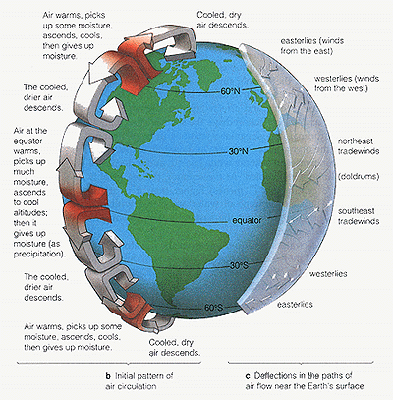 | 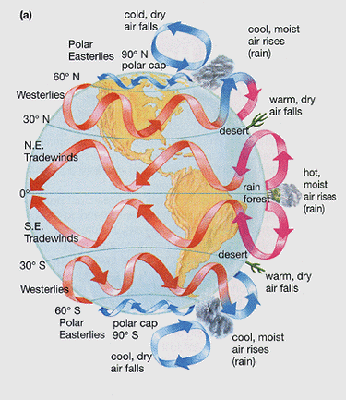 |
| Circulation of air on the surface of the Earth. | The circulation is modified by the rotation of the Earth around its axis (Coriolis effect) |
Aerial photograph of the Earth taken by the Apollo crew. Clouds are visible above much of the Congo basin, where rainforest occurs, whereas the sky is clear above the desert regions due to descending air masses.
The distribution of different biomes on the Earth.
Climograph of North American biomes.
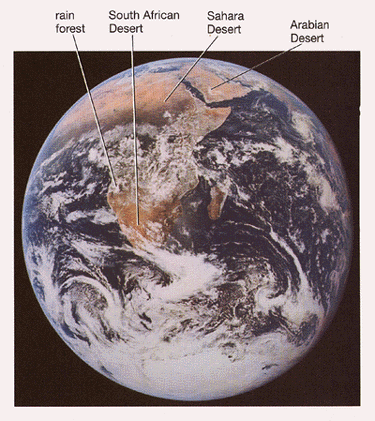
tundra -- taiga -- temperate deciduous forest -- grasslands -- desert -- savanna --tropical rainforests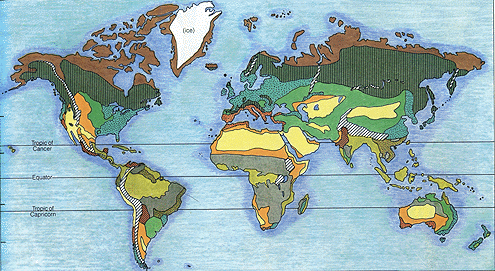
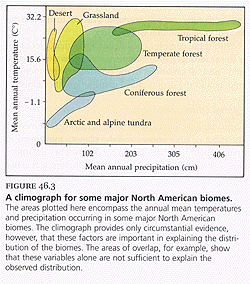
Reindeer in the tundra at Kolyma
Tundra occurs between the taiga and the permanently frozen polar regions. The annual precipitation is usually less than 250 mm, and water is not available for living organisms most of the time. During summer months (mostly July and August), the upper layer of the soil thaws, but half a meter underground the soil remains frozen. As a result of the permafrost, short summers and very long cold winters, no trees occur in the tundra. Bogs, ponds and herbaceous plants (and billions of mosquitoes) characterize the landscape, and even the few woody plants (Dwarf Birch, Arctic Willow) are dwarf.
Taiga forest in Canada
Taiga with lakes in the Alaskan wilderness
Mountain coniferous forest in the Yu Long Xue Mountains, NW Yunnan, China
Taiga or coniferous forest zone occupies a wide belt between the tundra and the temperate forests on the American and Eurasian continents. It is characterized by short cool summers (but longer than in the tundra) and long, dry, cold winters. The precipitation is only 300-500 mm annually, and most of it is in the form of snow. The snow usually melts before the upper layers of the soil thaws, and thus much of the water is drained into streams and rivers instead of soaking into the ground. The forest trees are typically different species of firs, spruces and larches mixed with birch toward the south. The soil is grayish with a shallow humus layer, poor in nutrients and acidic with a permanently frozen layer at various depth.
Forest in the Great Smoky Mountains
North American beech-maple forest
Interior of a European beech forest
Temperate Deciduous Forest in China
False-beech forest in New Zealand
Temperate or broadleaved deciduous forests receive 600-2500 mm precipitation annually, which is more or less evenly distributed throughout the year. Where the annual precipitation exceeds 1500 mm, the forest are referred to as temperate rainforests (such forests occur in the Cascade Range in the Northwestern US.) The winters are much milder and shorter than those in the taigawith only one or two month below freezing. Characterized by many species of oak, ash, beech, maple and elm, this biome is also rich in understory shrubs and herbaceous plants that are particularly dominant in the spring. The vegetation exhibits seasonal changes with growth mostly occurring during spring and summer. The soil has a well developed and thick humus layer which is usually brown; however, due to the large amount of precipitation, the soil is typically acidic.
Short-grass prairie in South Dakota
Short-grass prairie in Texas
Mixed-grass steppe in Southern Russia
The protected mixed-grass steppe at Homutovo, SE Ukraine
Short-grass steppe in Mongolia
Short-grass alkali-steppe in Manchuria, NE China
South American pampa
Temperate grasslands usually occur between the broadleaved forest and desert biomes. They receive 250-600 mm rainfall during mostly the summer months. The winters are cold and dry. Due to slow decomposition, the soil accumulates huge amounts of humus, whose black layer may be more than a meter thick (hence the name of the soil: black earth, black land, chernozem). The little precipitation does not support trees, but grasses and herbs are present in great abundance. Depending on the amount of rainfall, there are varieties of grasslands such as tallgrass, mixedgrass or shortgrass prairies and steppes. In the latter, drought tolerant grasses (such as feathergrass and buffalograss) and annual plants predominate. Grasslands in North America are called prairie, in Eurasia they are called steppe (in Hungary it is the puszta), and in South America pampa. Grasslands support a large number of herbivores from antelopes, horses and bisons to mice, groundsquirrels and gophers.
The Mojave Desert
The Chihuahuan Desert in Texas
The Great Basin Desert in Nevada
The Sonoran Desert in Mexico
The Atacama in Chile
Life in the American deserts
The Kara Kum desert in Uzbekistan
Desert sand dunes in Kazakhstan
The Taklimakan Desert in Western China
Desert in the Turfan Basin, China
Deserts are places where there is less than 250 mm annual precipitation. The precipitation is unpredictable; there are long periods of drought lasting for eight to ten years. Warm deserts experience very mild winters with few freezing days (Sonoran, Chihuahuan, Saharan deserts), whereas cold deserts have an extended period of winter with termperatures well below freezing (Taklimakan, Gobi). Plant cover is sparse, and characterized by drought tolerant brushes, succulent and annual plants. Deserts are particularly rich in reptiles (snakes and lizards) and rodents (gerbils, jerboas and kangaroo rats), and most of the animals are nocturnal (active at night). The soil is very poor in nutrients, and the humus layer is absent or only weakly developed.
The Ngorongoro Crater
The Serengeti
Savanna near the Okawango Delta, Botswana
Savanna in South Africa
Savanna in Brazil
Toward the warmer climates, the intermediate biome between deserts and the tropical forests is the savanna and thorn bush. There is 900-1500 mm of rain each year, with a pronounced wet or rainy, and an almost equally long dry season. The temperatures are high year long, which results in droughts during the dry season, when most plants die or dry out. Trees are typically drought tolerant (baobab, acacia). Soils are relatively nutrient poor due to leaching out during the rainy seasons. Trees are widely spaced, and the majority of the vegetation is different species of grasses. Fire is important in the maintenance of the savanna, and many plant species are fire tolerant, or even require fire for growth and germination.
Tropical rainforest in southeast Costa Rica
Montane rainforest in Costa Rica
Life in the American rainforests
Tropical rainforest in Malaysia
Montane rainforest on Mount Kinabalu, Kalimantan
Tropical rainforest on New Guinea
Tropical lowland rainforest in Central Africa
Ndoki, "the last place on Earth"
Montane rainforest in the Rwenzori Mountains, Uganda
Lowland rainforest in Madagascar
Montane rainforest in eastern Madagascar
Life in the African rainforests
Tropical rainforests occur close to the Equator, where temperature fluctuates only little, and the precipitation is more or less evenly distributed throughout a year. The annual rainfall is between 2000-5000 mm (up to 17 feet!), and as a consequence, the humidity is very high. Due to the excess rainfall and rapid decomposition, the soils are very devoid of nutrients. Most of the organic matter is in the form of litter (dead material) or in living organisms. The lowland rainforests (or jungle) are located near the sea level, whereas at higher elevations, montane rainforests or cloud forests develop. The vegetation is lush with many layers in the canopy that support an incredible diversity of life.
Tropical rainforest in northern Costa Rica
School of Biological
Sciences | College of Natural Science
The University of Texas at Austin |
Biological Sciences Computer Support
Facility